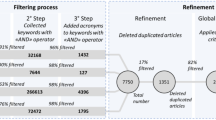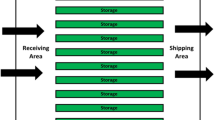Abstract
A multiproduct assembly system produces a family of similar products, where the assembly of each product entails an ordered set of tasks. An assembly system consists of a sequence of workstations. For each workstation, we assign a subset of the assembly tasks to be performed at the workstation and select the type of assembly equipment or resource to be used by the workstation. The assembly of each product requires a visit to each workstation in the fixed sequence. The problem of system design is to find the system that is capable of producing all the products in the desired volumes at minimum cost. The system cost includes the fixed capital costs for the assembly equipment and tools and the variable operating costs for the various workstations. We present and illustrate an optimization procedure that assigns tasks to workstations and selects assembly equipment for each workstation.
Similar content being viewed by others
References
Baybars, I. A Survey of Exact Algorithms for the Simple Assembly Line Balancing Problem.Management Science 32: 909–932 (August 1986).
Chakravarty, A. K. and Shtub, A., “Balancing Mixed Model Lines with In-Process Inventories”,Management Science, 31: 1161–1174 (September 1985).
Chakravarty, A. K. and Shtub, A., “Integration of Assembly Robots in a Flexible Assembly System”, inFlexible Manufacturing Systems: Methods and Studies, A. Kusiak (Editor), Elsevier Science Publishers B.V. (North-Holland), New York, pp. 71–88 (1986).
DeFazio, T. L. and Whitney D. E., Simplified Generation of All Mechanical Assembly Sequences.IEEE Journal of Robotics and Automation, Vol. RA-3, No. 6: 640–658 (December 1987).
Graves, S. C. and Lamar B. W. Integer Programming Procedure for Assembly System Design Problems.Operations Research 31: 522–545 (May–June 1983).
Graves, S. C. and Whitney, D. E., A Mathematical Programming Procedure for Equipment Selection and System Evaluation in Programmable Assembly. InProceedings of the Eighteenth IEEE Conference on Decision and Control, 531–536, (1979).
Gustavson, R. E. Design of Cost-Effective Assembly Systems. C.S. Draper Laboratory Report No. P-2661, Cambridge, Mass. (1986).
Holmes, C. A. Equipment Selection and Task Assignment for Multiproduct Assembly System Design. Master's Thesis, Operations Research Center, Massachusetts Institute of Technology, Cambridge, Mass. (1987).
Kao, E. P. C. and Queyranne, M., On Dynamic Programming Methods for Assembly Line Balancing.Operations Research 30: 375–390 (March 1982).
Lamar, B. W. Optimal Machine Selection and Task Assignment in an Assembly System Design Problem. Master's Thesis, Operations Research Center, Massachusetts Institute of Technology, Cambridge, Mass. (1980).
Macaskill, J. L. C. Production Line Balancing for Mixed-Model Lines.Management Science 19: 423–434 (December 1972).
Pinto, P. A., Dannenbring D. G. and Khumawala, B. M. Assembly Line Balancing with Processing Alternatives: An Application.Management Science 29: 817–830 (July 1983).
Schrage, L. and Baker, K. R. (1978). Dynamic Programming Solutions of Sequencing Problems with Precedence Constraints.Operations Research 26: 444–449 (June 1978).
Thomopolous, N. T. Line Balancing-Sequencing for Mixed-Model Assembly.Management Science 14: 59–75 (October 1967).
Mixed-Model Line Balancing with Smoothed Station Assignments.Management Science 16: 593–603 (May 1970).
Whitney, D. E., DeFazio, T. L., Gustavson, R. E., Graves, S. C., Holmes, C. and Klein, C. J., Computer-Aided Design of Flexible Assembly Systems: First Report. C.S. Draper Laboratory Report No. CSDL-R-1947, Cambridge, Mass. (1986).
Whitney, D. E., Nevins, J. L., DeFazio, T. L., Gustavson, R. E., Metzinger, R. W., Rourke, J. M. and Seltzer, D. S., The Strategic Approach to Product Design. C.S. Draper Laboratory Report No. CSDL-P-2742, Cambridge, Mass. (1986).
Author information
Authors and Affiliations
Rights and permissions
About this article
Cite this article
Graves, S.C., Redfield, C.H. Equipment selection and task assignment for multiproduct assembly system design. Int J Flex Manuf Syst 1, 31–50 (1988). https://doi.org/10.1007/BF00713158
Issue Date:
DOI: https://doi.org/10.1007/BF00713158




